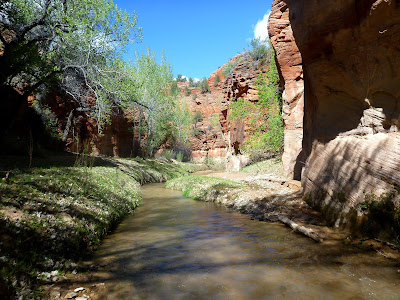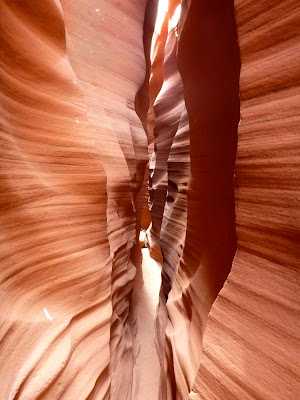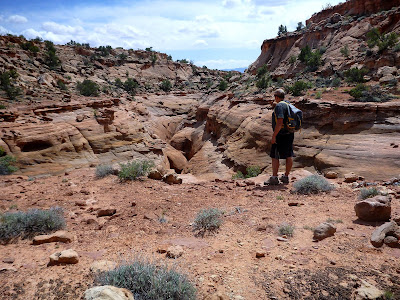Note: For Context, see part one of this blog entry, where I detail the first 7 days in southern Utah, including Bryce Canyon, Capitol Reef, and Escalante. I ended that blog post with a drive back to the Mt Carmel area, ready to start hiking in Parunuweap Canyon the next day. (for those paying attention, this also meant I visited all five Utah national parks. I did this in 2013 over a 12 month stretch – this time I did it over the course of 3 weeks!)
On Monday morning, I left my motel room in Orderville and headed into Zion National Park. Shortly inside the park I pulled off the road, just past the Checkerboard Mesa exit. I held up a sign reading “Mt Carmel Junction,” and stuck out my thumb.
This was my first time hitchhiking since 2012 on the Great Divide Trail in Canada. I ended up waiting about 40 minutes, until a lady who was taking some photographs across the road took pity on me as she watched the cars pass me, and ended up taking me back out of Zion and up the highway to Mt. Carmel. She was on a week-long trip from Michigan, having visited Grand and Bryce Canyons over the weekend, and planning a trip to Antelope Canyon, Monument Valley and on up into Moab after she got done with Zion. I gave her some advice on the better easy trails in Zion in exchange for the ride.
The East Fork of the Virgin River flows under the highway just a half-mile south of Mt Carmel Junction. I passed through the bizarrely out-of-place golf course behind the gas station at Mt Carmel, and dropped onto a dirt road paralleling the river, which was more of a creek at this stage.
The first few miles of Parunuweap were nothing to get excited about. The canyon is open and shadeless, and ATVs buzz along the road alarmingly often. There’s some scenic white cliffs, but the hiking overall is monotonous. Maybe a mile below the highway, you skirt below a private ranch house at the Barracks Ranch. Another mile, and the dirt road finally leaves the canyon, taking the ATVs with it.
Below the road, I started walking in and next to the creek. This was a little more pleasant, but the canyon was still relatively open and hot, and filled with cows and their offal. The cows would continue all the way down as low as Poverty Wash, but in the upper section they are legion. Unlike the North Fork/Zion Narrows, the East Fork takes its time revealing its beauty.
In the late afternoon, I reached a sandbar across from the mouth of Mineral Gulch. I dropped my pack here and hiked up Mineral Gulch, through 3 sets of pretty narrows.
In the third and final narrows, I found two relatively fresh deer carcasses. They had obviously stumbled off the cliffs above and fell down into the slot. I found myself wondering what drama had ensued above to force the deers over the edge of the cliff. Usually they were so fleet of foot, it was hard to imagine them stumbling accidentally.
The next morning, I headed deeper into the canyon. Parunuweap remain relatively wide and sunny for the first part of the day, with a riot of green foliage lining either side of the creek.
Mid-morning, I reach the mouth of Rock Canyon. I explored upstream here, finding it a pretty, green, heavily vegetated drainage much like the main drainage.
However, there was a very short section of slot narrows to remind you why you were there, and what kind of terrain lay downstream.
Back in the main canyon, I left my pack and backtracked a bit from the mouth of Rock Canyon, using the canyon mouth as a landmark to navigate to some petroglyphs marked on the map. This turned out to be well-worth the detour, with a profusion of detailed petroglyphs etched into a cliff wall.
Below Rock Canyon, Parunuweap started to get interesting. Huge sandstone walls started to rear up from one side of the creek or the other. These walls were usually decorated with ferns, desert varnish, and beautiful flowing water beneath.
In the afternoon, I passed the Desolation Gullies, another side canyon (actually a set of two side canyons) that were lauded by the website I pulled beta from. I went a short distance up these gullies, but found them wide, sandy and uninteresting. I pressed further on down the creek.
As the day passed, the scenery progressively got better and better. Huge rock walls loomed out of the river with greater and greater frequency, at times pushing in from both sides to form narrows. This was finally starting to look more like the Zion Narrows I knew and loved.
At the end of Day 2, I pulled up to the mouth of Poverty Wash. This was another recommended side canyon. I was jolted a little bit to see a pack at the mouth of the canyon, indicating someone was up there ahead of me. After not seeing a soul for two days, it was a bit of shock to realize I didn’t have this place to myself. I headed on up Poverty Wash.
Eventually, I ran into the owner of the pack, and it couldn’t have been more of a surprise. Being a fan of long-distance hiking and Utah, I’ve followed the exploits of Jamal Jamie Green through his acrossutah.com website for a few years. He’s done a bunch of long-distance, DIY routes through the Utah backcountry, and he’s got a bunch of fun vids on youtube. Shortly before the trip, I searched him out and sent him a friend request on facebook, so I knew from his posts he was starting another long-distance hike in Utah around the time I was up there. By some strange coincidence, he was the owner of the pack, and I ran into him a little way up Poverty Wash. I recognized him, and I think he was a little taken aback to run into someone who knew his name in some obscure drainage out in the Utah backcountry. We chatted for a few minutes then went our separate ways. I went further up Poverty Wash, which closed in with some very pretty deep dark narrows.
Eventually I returned to Parunuweap Canyon and set up camp for a second night.
The last day was the best day of the trip, though it was unfortunately short. Shortly below Poverty Wash, you reach the so-called “boulder obstacle.” This is a small falls where you have the option of a sketchy downclimb directly next to the falls (with a swim to exit), or an easier crack climb through a narrow tunnel next to the falls. I opted for the tunnel.
Below the boulder obstacle is the golden section of Parunuweap known as the Zion Barracks, where huge sandstone walls soar out of either side of the creek. The scenery here is as good as Zion Narrows, and worth all the effort you put in to get here.
After several turns of the canyon, Fat Man’s Misery canyon spills in from the north. You can only make your way into this canyon a little bit before it gets technical, but man is it beautiful.
The section of Misery Canyon you can access is wall to wall water, which is surprisingly warm thanks to a hot springs that flows into the canyon right before the exit. The water temperature means that the canyon is humming with life. The walls of the canyon were draped with moss and ferns, and literally hundreds of frogs clung to every available surface.
Entering the canyon, the frogs would do kamikaze dives into the water when they saw you coming. This is always entertaining in a normal canyon, and here it was completely over-the-top as dozens of frogs hit the water at the same time.
I made my way as far up the canyon as I could before turning around. Fat Man’s Misery is DEFINITELY on my short list of Zion technical canyons to run through in the future.
Below Fat Man’s Misery, Zion Barracks hit it’s crescendo. Glowing walls rose from flowing, beautiful water. This section of canyon was on par with Wall Street in Zion Narrows, a place so beautiful your whole being hums.
Unfortunately, it was over all too quick. Just around the corner from the mouth of Fat Man’s Misery, a breach in the canyon walls on the north allows access to the rim. Although steep and treacherous, this was the route out of the canyon. At the base of this “trail” I found a plaque honoring John Wesley Powell, who explored the canyon in 1872 and was the one who dubbed it Parunuweap.
The narrows continue below the Powell Plaque, and I followed them for a half-mile, across the official boundary of Zion National Park.
Eventually, the canyon reaches Labyrinth Falls. This marks the official turnaround point; below the falls the canyon’s been declared off-limits. Which is a shame, as it looks like the spectacular scenery continues.
Back at the Powell Plaque, the route climbs steeply up to the rim of the canyon. The first section of the route is the worst, and degenerates into hand-over-feet climbing. At one point, I got sketched out enough that I shed my pack and tied a piece of webbing to it. I went up the climb packless, then hauled my pack up after me.
The technical part of the exit doesn’t last long. On the rim, the grade moderates, and a sketchy trail forms that leads up towards Checkerboard Mesa. I’d been curious for a long time about hiking in the east end of the park, not down in the canyons but over the slickrock domes and mesas, and it was nice to finally explore and see what this terrain looked like, not from the car but on foot.
That’s not to say it was all fun. Although the grade wasn’t too bad, there was lots of sand slogging, and very little shade. The temperatures in April were not too bad, but I couldn’t picture trying to do this hike in summer. By the time I reach the pass on the west side of Checkerboard Mesa, I was pooped.
From the pass, you follow a canyon down the west side of Checkerboard Mesa. It’s a nice reprieve from the heat, and has some minor narrows that you bypass. Mostly, I was happy to zoom through this canyon and hit the road to Springdale and a cold beer.
Following the hike down Parunuweap, I went and stayed with a friend who lives in Hurricane, Utah. We had met the previous year during a canyoneering class in Escalante, Utah, and a friendship had solidified over a series of technical backpacking/canyoneering trips in the Grand Canyon in the fall and spring. He very generously agreed to host me overnight so we could go and do a technical canyon together the next day.
We debated some potential places to go, including back into Zion, and eventually settled on the Silver Reef, an area in the Dixie National Forest just outside of Hurricane, which is very popular with the locals. It features a number of excellent canyons, none of which require permits and which usually have less people than the canyons in Zion.
Yankee Doodle was the canyon of choice. This was a short canyon with a very good effort:reward ratio, that is a popular spot where local guides teach canyoneering classes. From the road, you walk less than two minutes to the head of the canyon and drop right in in a series of easy rappels.
As per usual for canyon country, the scenery was fabulous.
We ended up rappelling a bunch of short drops that maybe could have been downclimbed. Both of us are relatively experienced canyoneers, so this was interesting to me. Rappelling is the safer choice, of course. I think the fact that it was just the two of us helped drive this choice. With only two people (and both of us were fast and efficient rappellers) the rappel stations didn’t turn into the bottlenecks they are with larger groups. We could rig the anchor, deploy the rope, rappel down, and pack the rope back up almost as fast as if we had stopped to downclimb - especially as some of these downclimbs would have required hand lines anyway. And we were much safer than had we downclimbed everything. Some of these little drops had nasty undercuts or other issues you couldn’t necessarily see from the top. Anyway, it was an interesting dynamic and seemed to work out well. We did end up downclimbing some drops later in the canyon.
In less than two hours, we finished the canyon, and after a pretty sketchy climb straight up a slickrock slope, we exited the canyon and were back at the car. After returning to Hurricane, I hit the road and drove onward.
Near Page, I pulled off the road again. There is a very nice, short and sweet canyon just outside of Page known as Blue Pools. I had been through this canyon last year on the return from the canyoneering class in Escalante. This is a very easy canyon, with only two rappels of consequence. I stopped here and ran the canyon solo, returning to my car in less than two hours.
And that was it for my southern Utah ramble! After Blue Pools, I drove straight through back to Phoenix. It’s been three weeks now since the trip and I’m still flashing back on it. I can’t wait to get back in that glorious country again!








































































